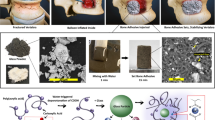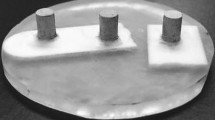Abstract
A gallium (Ga) glass series (0.48SiO2–0.40ZnO–0.12CaO, with 0.08 mol% substitution for ZnO) was developed to formulate a Ga-containing Glass Polyalkenoate Cement (GPC) series. Network connectivity (NC) and X-ray Photoelectron Spectroscopy (XPS) was employed to investigate the role of Ga3+ in the glass, where it is assumed to act as a network modifier. Ga-GPC series was formulated with E9 and E11 polyacrylic acid (PAA) at 50, 55 and 60 wt% additions. E11 working times (T w ) ranged from 68 to 96 s (Lcon.) and 106 s for the Ga-GPCs (LGa-1 and LGa-2). Setting times (T s ) ranged from 104 to 226 s (Lcon.) and 211 s for LGa-1 and LGa-2. Compression (σc) and biaxial flexural (σf) testing were conducted where Lcon. increased from 62 to 68 MPa, LGa-1 from 14 to 42 MPa and LGa-2 from 20 to 47 MPa in σc over 1–30 days. σf testing revealed that Lcon. increased from 29 to 42 MPa, LGa-1 from 7 to 32 MPa and LGa-2 from 12 to 36 MPa over 1–30 days.









Similar content being viewed by others
References
Hench L, Peitl O, Zanotto ED. Highly bioactive P2O5–Na2O–CaO–SiO2 glass ceramics. J Non Cryst Sol. 2001;292:115–26.
Hench LL. The story of bioglass. J Mater Sci Mater Med. 2006;17:967–78.
Kokubo T, Takadama H. How useful is SBF in predicting in vivo bone bioactivity. Biomaterials. 2006;27:2907–15.
Kokubo T, Kim H-M, Kawashita M. Novel bioactive materials with different mechanical properties. Biomaterials. 2003;24:2161–75.
Heikkilä JT, Aho AJ, Kangasniemi I, Yli-Urpo A. Polymethylmethacrylate composites: disturbed bone formation at the surface of bioactive glass and hydroxyapatite. Biomaterials. 1996;17(18):1755–60.
Daglilar S, Erkan ME, Gunduz O, Ozyegin LS, Salman S, Agathopoulos S, Oktar FN. Water resistance of bone-cements reinforced with bioceramics. Mater Lett. 2007;61(11–12):2295–8.
Lacefleld WR, Hench LL. The bonding of Bioglass® to a cobalt-chromium surgical implant alloy. Biomaterials. 1986;7(2):104–8.
Fu Q, Rahaman MN, Sonny Bal B, Brown RF, Day DE. Mechanical and in vitro performance of 13–93 bioactive glass scaffolds prepared by a polymer foam replication technique. Acta Biomater. 2008;4(6):1854–64.
Rezwan K, Chen QZ, Blaker JJ, Boccaccini AR. Biodegradable and bioactive porous polymer/inorganic composite scaffolds for bone tissue engineering. Biomaterials. 2006;27(18):3413–31.
Boccaccini AR, Blaker JJ, Maquet V, Day RM, Jérôme R. Preparation and characterisation of poly(lactide-co-glycolide) (PLGA) and PLGA/Bioglass® composite tubular foam scaffolds for tissue engineering applications. Mater Sci Eng, C. 2005;25:123–31.
Brown RF, Day DE, Day TE, Jung S, Rahaman MN, Fu Q. Growth and differentiation of osteoblastic cells on 13–93 bioactive glass fibers and scaffolds. Acta Biomater. 2008;4(2):387–96.
Cannillo V, Chiellini F, Fabbri P, Sola A. Production of Bioglass® 45S5-Polycaprolactone composite scaffolds via salt-leaching. Compos Struct. 2010;92(8):1823–32.
Chen QZ, Thompson ID, Boccaccini AR. 45S5 Bioglass®-derived glass-ceramic scaffolds for bone tissue engineering. Biomaterials. 2006;27(11):2414–25.
Chen Q-Z, Rezwan K, Françon V, Armitage D, Nazhat SN, Jones FH, Boccaccini AR. Surface functionalization of Bioglass®-derived porous scaffolds. Acta Biomater. 2007;3(4):551–62.
Jones JR, Ehrenfried LM, Hench LL. Optimising bioactive glass scaffolds for bone tissue engineering. Biomaterials. 2006;27:7964–73.
Vargas GE, Mesones RV, Bretcanu O, López JMP, Boccaccini AR, Gorustovich A. Biocompatibility and bone mineralization potential of 45S5 Bioglass®-derived glass-ceramic scaffolds in chick embryos. Acta Biomater. 2009;5(1):374–80.
Hatton PV, Hurrell-Gillingham K, Brook IM. Biocompatability of glass ionomer bone cements. J Dent. 2006;34:598–601.
Nicholson JW, Wilson AD. Chemistry of solid state materials Vol 3: acid–base cements—their biomedical and industrial applications. Cambridge: Cambridge University; 1993.
Billington RW, Williams JA, Pearson GJ. Ion processes in glass ionomer cements. J Dent. 2006;34:544–55.
Carter DH, Sloan P, Brook IM, Hatton PV. Role of exchanged ions in the integration of ionomeric (glass polyalkenoate) bone substitutes. Biomaterials. 1997;18:459–66.
Van Duinen RNB, Kleverlaan CJ, de Gee AJ, Werner A, Feilzer AJ. Early and long-term wear of ‘Fast-set’ conventional glass–ionomer cements. Dent Mater. 2005;21(8):716–20.
Cho S, Cheng AC. A review of glass ionomer restorations in the primary dentition. J Can Dent Assoc. 1999;65:491–5.
Smith DC. Development of glass–ionomer cement systems. Biomaterials. 1998;19:6467–78.
Tyas MJ, Burrow MF. Adhesive restorative materials: a review. Aust Dent J. 2004;49(3):112–21.
DeBruyne MAA, DeMoor RJG. The use of glass ionomer cements in both conventional and surgical endodontics. Int Endo J. 2004;37:91–104.
Firling CE, Hill TA, Severson AR. Aluminium toxicity perturbs long bone calcification in the embryonic chick. Arch Toxicol. 1999;73:359–66.
Hoang-Xuan K, Perrotte P, Dubas F, Philippon J, Poisson FM. Myoclonic encephalopathy after exposure to aluminium. Lancet. 1996;347:910–1.
Reusche E, Pilz P, Oberascher G, Linder B, Egensperger R, Gloeckner K, Trinka E, Iglseder B. Subacute fatal aluminium encephalopathy after reconstructive otoneurosurgery: a case report. Hum Pathol. 2001;32(10):1136–9.
Boyd D, Clarkin OM, Wren AW, Towler MR. Zinc-based glass polyalkenoate cements with improved setting times and mechanical properties. Acta Biomater. 2008;4(2):425–31.
Boyd D, Towler MR. The processing, mechanical properties and bioactivity of zinc based glass ionomer cements. J Mater Sci Mater Med. 2005;16:843–50.
Boyd D, Towler MR, Watts S, Hill R, Wren AW, Clarkin OM. The role of Sr2+ on the structure and reactivity of SrO–CaO–ZnO–SiO2 ionomer glasses. J Mater Sci Mater Med. 2008;19:953–7.
Boyd D, Towler MR, Wren AW, Clarkin OM. Comparison of an experimental bone cement with surgical simplex p, spineplex and cortoss. J Mater Sci Mater Med. 2007;19(4):1745–52.
Wren AW, Kidari A, Cummins NM, Towler MR. A spectroscopic investigation into the setting and mechanical properties of titanium containing glass ionomer cements. J Mater Sci Mater Med. 2010;21:2355–64.
Wren AW, Laffir FR, Kidari A, Towler MR. The structural role of titanium in Ca–Sr–Zn–Si/Ti glasses for medical applications. J Non Cryst Sol. 2010;357:1021–6.
Wren AW, Cummins NM, Laffir FR, Hudson SP, Towler MR. The bioactivity and ion release of titanium-containing glass polyalkenoate cements for medical applications. J Mater Sci Mater Med. 2011;22:19–28.
Ortega R, Suda A, Devès G. Nuclear microprobe imaging of gallium nitrate in cancer cells. Nucl Instrum Methods Phys Res Sect B Beam Inter Mater Atoms. 2003;210:364–7.
Chitambar CR. Medical applications and toxicities of gallium compounds. Int J Environ Res Public Health. 2010;7(52):337–61.
Collery P, Keppler B, Madoulet C, Desoize B. Gallium in cancer treatment. Crit Rev Oncol Hematol. 2002;42(3):283–96.
International Organization for Standardization 9917. Dental water based cements (E), in Case Postale 56. 1991: Geneva, Switzerland. p. CH-11211.
Williams JA, Billington RW, Pearson GJ. The effect of the disc support system on biaxial tensile strength of a glass ionomer cement. Dent Mater. 2002;18(5):376–9.
Romand M, Roubin M, Deloume J-P. X-ray photoelectron emission studies of mixed selenides AgGaSe2 and Ag9GaSe6. J Sol State Chem. 1978;25:159–64.
Gray RC, Carver JC, Hercules DM. An ESCA study of organosilicon compounds. J Elec Spec Rel Phen. 1976;8:5343–57.
Bahna P, Dvorak T, Hanna H, Yasko AW, Hachem R, Raad I. Orthopaedic metal devices coated with a novel antiseptic dye for the prevention of bacterial infection. Int J Anti Agents. 2007;29:593–6.
Author information
Authors and Affiliations
Corresponding author
Rights and permissions
About this article
Cite this article
Wren, A.W., Coughlan, A., Placek, L. et al. Gallium containing glass polyalkenoate anti-cancerous bone cements: glass characterization and physical properties. J Mater Sci: Mater Med 23, 1823–1833 (2012). https://doi.org/10.1007/s10856-012-4624-4
Received:
Accepted:
Published:
Issue Date:
DOI: https://doi.org/10.1007/s10856-012-4624-4




